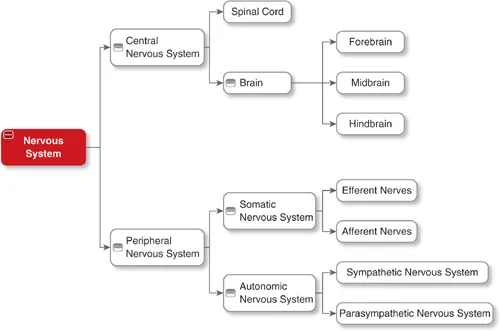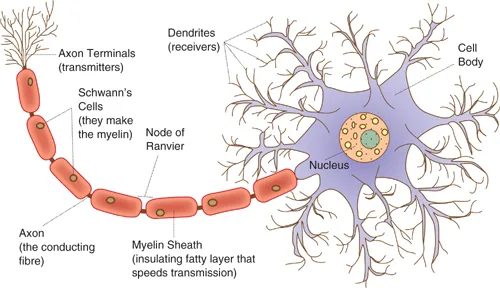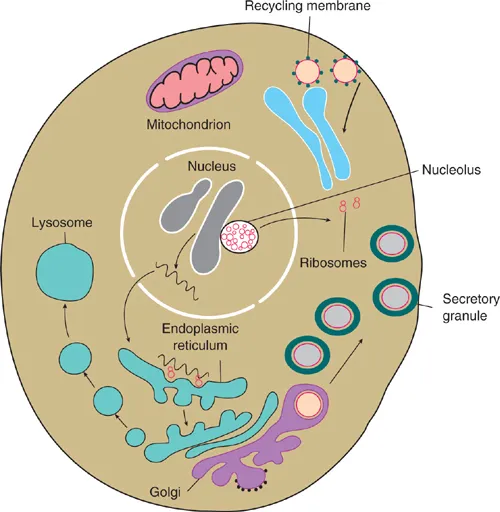
- 416 pages
- English
- ePUB (mobile friendly)
- Available on iOS & Android
eBook - ePub
Essential Biological Psychology
About this book
Drawing on the latest exciting research, Essential Biological Psychology provides students with a solid grasp of the relationship between mind and behaviour, and a detailed understanding of the underlying structure and physiological mechanisms that underpin it. The functions of the nervous system are explained and implications for health are explored. Throughout the book, Jim Barnes encourages students to evaluate essential concepts and theoretical issues.
Features include:
- key concepts highlighted throughout the text enables students to grasp the fundamental knowledge and understanding of the structures and functions of the human nervous system that are relevant to the study of psychology
- the snapshot of key studies detailed in the textboxes allow critical evaluation of the role of physiology in human behaviour against a backdrop of up to date research
- clear explanations of the key methods in the text give students an appreciation of the contributions made by the different approaches and research methods that are used in biological psychology
- memory maps and diagrams within the text encourage learning and allow students to formulate memory aids to assist recall in exam conditions
- a companion website consists of PowerPoint lecture slides and a testbank for teachers (50 questions per chapter) as well as interactive self-assessment testbank for students (10 questions per chapter)
Frequently asked questions
Yes, you can cancel anytime from the Subscription tab in your account settings on the Perlego website. Your subscription will stay active until the end of your current billing period. Learn how to cancel your subscription.
No, books cannot be downloaded as external files, such as PDFs, for use outside of Perlego. However, you can download books within the Perlego app for offline reading on mobile or tablet. Learn more here.
Perlego offers two plans: Essential and Complete
- Essential is ideal for learners and professionals who enjoy exploring a wide range of subjects. Access the Essential Library with 800,000+ trusted titles and best-sellers across business, personal growth, and the humanities. Includes unlimited reading time and Standard Read Aloud voice.
- Complete: Perfect for advanced learners and researchers needing full, unrestricted access. Unlock 1.4M+ books across hundreds of subjects, including academic and specialized titles. The Complete Plan also includes advanced features like Premium Read Aloud and Research Assistant.
We are an online textbook subscription service, where you can get access to an entire online library for less than the price of a single book per month. With over 1 million books across 1000+ topics, we’ve got you covered! Learn more here.
Look out for the read-aloud symbol on your next book to see if you can listen to it. The read-aloud tool reads text aloud for you, highlighting the text as it is being read. You can pause it, speed it up and slow it down. Learn more here.
Yes! You can use the Perlego app on both iOS or Android devices to read anytime, anywhere — even offline. Perfect for commutes or when you’re on the go.
Please note we cannot support devices running on iOS 13 and Android 7 or earlier. Learn more about using the app.
Please note we cannot support devices running on iOS 13 and Android 7 or earlier. Learn more about using the app.
Yes, you can access Essential Biological Psychology by Jim Barnes in PDF and/or ePUB format, as well as other popular books in Psychology & Physiological Psychology. We have over one million books available in our catalogue for you to explore.
Information
 | NEURONS, NEUROTRANSMISSION AND COMMUNICATION |
CHAPTER OUTLINE
How the nervous system is organised
Cells of the nervous system
The neuron
Neuroglial cells
Information exchange in the nervous system
The resting membrane potential
The action potential and nerve impulse
Summation effects
Synaptic transmission
The synaptic vesicle
Modulation of synaptic transmission
Non-synaptic chemical communication
Postsynaptic receptors and receptor types
Neurotransmitters
The amino acids
Monoamines
Acetylcholine
Neuropeptides and neuromodulators
Soluble gases
Summary
Further reading
Key questions
The purpose of biological psychology is to elucidate the biological mechanisms involved in behaviour and mental activity. Biological psychologists (sometimes referred to as neuropsychologists) attempt to understand how the neural circuits and connections are formed and put together during the development of the brain, allowing the individual to perceive and interact with the world around them. We cannot answer all of the questions that we would like to, nor do we believe that we have access to the best possible tools for studying the brain, but the questions do stir up curiosity and a better understanding of the biological processes that play a role in behaviour. It can be hard to remember the complicated names of nerve cells and brain areas. However, to develop theories of behaviour regarding the brain, a psychologist must know something about brain structure. This chapter will focus on the nervous system: its organisation, its cell composition, and the type of chemical signals that make it possible for us to process an incredible amount of information on a daily basis.
HOW THE NERVOUS SYSTEM IS ORGANISED
In vertebrates, the nervous system has two divisions: the peripheral nervous system and the central nervous system (Figure 1.1). The central nervous system (CNS), which consists of the brain and spinal cord, is surrounded by another nervous system called the peripheral nervous system (PNS). The PNS gathers information from our surroundings and environment and relays it to the CNS; it then acts on the signals or decisions that the CNS returns. The peripheral nervous system itself consists of two parts: the somatic nervous system and the autonomic nervous system. The autonomic nervous system is divided into two subsystems: the parasympathetic nervous system and the sympathetic nervous system. The parasympathetic system is responsible for slowing the heart rate, increasing the intestinal and gland activity and undertaking actions when the body is at rest. Its action can be described as opposite to the sympathetic nervous system, which is responsible for controlling actions associated with the fight-or-flight response. The somatic system contains the sensory receptors and motor nerves which activate the skeletal muscles, and it is concerned with detecting and responding to environmental stimuli.

Figure 1.1 Components of the nervous system
CELLS OF THE NERVOUS SYSTEM
THE NEURON
Neurons are the basic information processing structures in the CNS. They are electrically excitable cells that process and transmit information around the nervous system. Neurons transmit information either by electrical or by chemical signalling, which as you will see later occurs via synapses. Neurons are the core apparatus of the nervous system, and a number of specialised types exist. Neurons are very much like other body cells, possessing common features like the following:
- Neurons are encased in a cell membrane (also known as a plasma membrane).
- The nucleus of a neuron contains chromosomes and genetic information.
- Neurons consist of cytoplasm (fluid found within the cell), mitochondria and other organelles.
- Basic cellular processes occur in a neuron. Ribosomes are where proteins are produced, and mitochondria are responsible for metabolic activities that energise the cell.
- Neurons contain a Golgi complex – a network of vesicles that get hormones and other products ready to be secreted.
However, neurons or nerve cells are different from other body cells in that:
- Extensions emanate from the central body of the neuron. We refer to these as dendrites and axons. Dendrites carry information to the cell body while axons transmit information away from the cell body.
- Neurons transmit and receive information via an electrochemical mechanism.
- Neurons have some distinct and specialised structures like the synapse (the junction between one neuron and the next).
- Neurons synthesise chemicals that serve as neurotransmitters and neuromodulators.
Neuron structure
A typical neuron possesses a cell body (the soma), dendrites and an axon. Dendrites are filaments that emanate from the cell body, branch numerous times and give rise to a complex dendritic tree (Figure 1.2). An axon is like the wire in an electrical cable. It starts at the cell body at a site called the axon hillock and travels to the site in the nervous system where it connects with another nerve cell or different type of cell, such as muscle. The cell body of a neuron frequently gives rise to multiple dendrites, but never to more than one axon. A layer of fatty cells called the myelin sheath segmentally encases the fibres of many neurons that greatly increase the transmission speed of neutral impulses. Table 1.1 summarises the differences between axons and dendrites.

Figure 1.2 Neuron structure
Table 1.1 Differences between axons and dendrites
Axons | Dendrites |
Take information away from the cell body | Bring information to the cell body |
Large axons have a distinct swelling called the axon hillock | No hillock |
Usually have few or no ribosomes | Usually have ribosomes |
Smooth surface | May have rough surface: spiny as in pyramidal cells or non-spiny as in interneurons |
Often covered with myelin | Seldom covered with myelin |
Generally only one axon or none per cell | Usually many dendrites per cell, each with many branches |
May be any length: 1 metre or longer | Usually shorter than axons |
Branch further from the cell body | Branch near the cell body |
Inside the neuron
The inside of a neuron is much like the other cells of the body in many ways, as a neuron has many of the same organelles, including a nucleus and mitochondria. Figure 1.3 shows the following components of a typical animal cell:
- Nucleus: contains genetic material within the chromosomes comprising information for development and maintenance of the cells as well as the production of proteins. The nucleus is covered by a membrane.
- Nucleolus: produces ribosomes, which are essential for translating genetic information into proteins.
- Lysosomes: contain enzymes that reduce chemicals to their individual components.
- Centrosome: this microtubule regulates the cells and the cell cycle.
- Cytoplasm: this is a partially transparent, gelatinous substance that fills the cell.

Figure 1.3 Cross-section of animal cell
- Vacuole: these are compartments bound by membranes that carry out various functions including storage and secretion of neurotransmitters.
- Endoplasmic reticulum (ER): a network of tubes that are used to move materials around the cytoplasm. Endoplasmic reticula which are made from ribosomes are called rough ER, whereas those which have no ribosomes are called smooth ER. ER including ribosomes are vital for protein synthesis.
- Golgi body or Golgi apparatus: a membrane-bound structure that is critical to the process of encasing peptides and proteins into vesicles.
- Microfilaments or neurotubules: the system that moves materials within a neuron. These elements can also be used for structural help.
Neuron classification
The study of the microscopic anatomy of cells and tissues is termed histology (see Box 1.1). As with many things in the nervous system, neurons may be classified in a variety of ways, according to their function (sensor, motor, interneuron), their location (cortical, subcortical), the identity of the neurotransmitter they synthesise and release (cholinergic, glutamatergic) and their shape (pyramidal, granule, etc.). One easy way to categorise them is by how their axons and dendrite leave their cell body or soma. This gives three main types of neurons:
- Bipolar: similar to retinal cells, two processes extend from the body of bipolar neurons.
- Unipolar: there are two dorsal root ganglion axons for each unipolar cell. One axon stretches out in the direction of the spinal cord and the other in the direction of the skin or muscles.
- Multipolar: multipolar neurons contain many processes that branch out from the cell body. However, here...
Table of contents
- Cover Page
- Title
- Copyright
- Summary of Contents
- Contents
- About the author
- Preface
- Companion Website
- Acknowledgements
- 1 Neurons, Neurotransmission and Communication
- 2 Neuroanatomy and Brain Mapping
- 3 Genes and Evolution
- 4 Development and Plasticity of the Brain
- 5 Visual System
- 6 Non-Visual Sensory Systems
- 7 Motor Control and Movement
- 8 The Biopsychology of Motivation
- 9 Sleep and Biological Rhythms
- 10 Biopsychology of Emotions, Stress and Health
- 11 Memory, Learning and Amnesia
- 12 Lateralisation and Language
- 13 Biological Basis of Behaviour Disorders
- Glossary
- References
- Name Index
- Subject Index